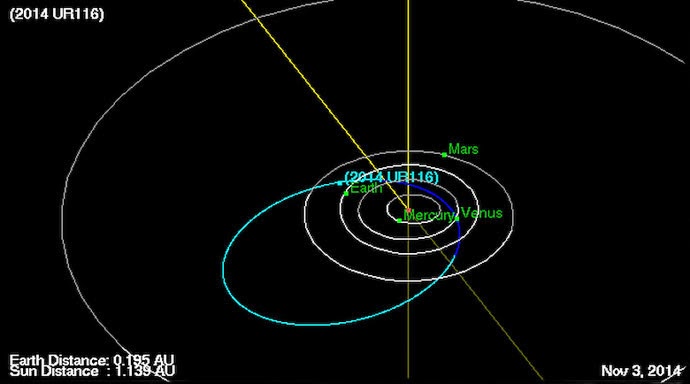Scientists have calculated that asteroid 2014 UR116 will fly in dangerous proximity to Earth every three years. If it collides with the planet the energy of the explosion could be a thousand times greater than the impact of the Chelyabinsk meteorite. Vladimir Lipunov, a leading scientist on the team which discovered the asteroid this October, says the scientists now know its orbit and its period which is 3 years, but they cannot say precisely when the asteroid will approach the Earth. “We should track it constantly. Because if we have a single mistake, there will be a catastrophe.
The consequences can be very serious,” he said in the documentary “Asteroids attack” posted on Roscosmos website. Lipunov believes that 2014 UR116 could hit Earth with an explosion 1,000 times greater than the surprise 2013 impact of a bus-sized meteor over Chelyabinsk, Russia.
The asteroid is about 370 meters in diameter. It was was discovered with the help of Russia's network of robotic telescopes which perform the sky survey without human direction and can create its own data bases. Its size exceeds the famous Apophis which the Earth can meet in the next decade.
The exact trajectory of 2014 UR116 is yet to be determined, but theoretically it may collide with the Earth, Mars or Venus. Its trajectory can fluctuate because of the gravitational pull of these planets.
It is also important to define the composition of an asteroid. If it consists of stone it generally breaks into small parts, but metal asteroid can reach the surface of Earth, according to Stanislav Korotky, Ka Dar observatory scientific director. The famous Arizona crater is the track of a metal asteroid.
There is little indication that this particular asteroid could hit the Earth in the next few decades, though over a much longer period a collision looks quite likely, says Natan Esmant, an expert with the official Space Research Institute in Moscow. A more serious issue, he says, is the estimated 100,000 near-Earth objects, such as asteroids and comets, which can cross our planet's orbit and are large enough to be dangerous.
Only about 11,000 have so far been tracked and cataloged.
"Every couple of days new ones are being discovered," he says. "Scientists have increasingly powerful tools to do this work, but there's a lot still to be done. Every object that crosses the Earth's path can be a potential threat."
 |
| Orbit of asteroid 2014 UR116 as of November 3. Credit: JPL/NASA |
Some specialists believe we can be sure for a certain period of time that no collision will happen. Viktoria Damm from the Siberian Geodesic Academy Planetarium told TASS news agency that when the asteroid flies near Mars, its trajectory may change. That’s why the time of approach is unknown but she believes it will not happen in the coming two years.
Roscosmos on Sunday refuted media allegations that it had made an official statement about the discovery of a new potentially dangerous asteroid.
"Today, a number of mass media wrongfully cited information from our website about the discovery of a new asteroid that might pose danger to the Earth,” Irina Zubareva, a Roscosmos spokeswoman, told TASS, adding that it was in the competence of scientists to dwell on potential danger of celestial bodies.
“This article posted on our website is a transcript of a programme of the Roscosmos television studio and has direct references to concrete scientists who study this problem. That means that citing of this information as an official statement of Roscosmos is wrongful,” she said.
Roscosmos plans to work out a special system to stand against dangerous asteroids by 2025. The agency wants to use new technologies to change the orbits of asteroids, including different kinds of robots, for instance, robots-cleaners to take away the space rubbish from Earth orbit.
Meanwhile, NASA is working on projects Orbita@home and Spacewatch and plans to deploy The Asteroid Terrestrial-impact Last Alert System (ATLAS) in 2015.
Since the Chelyabinsk meteor, which came as a complete surprise to experts, scientists have been warning about the danger and trying to pool their data in order to get a clearer picture of the swarms of debris that are lurking in space.




